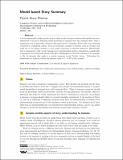Model-based Story Summary
Author(s)
Winston, Patrick Henry
DownloadPaper as submitted for publication (445.6Kb)
PUBLISHER_CC
Publisher with Creative Commons License
Creative Commons Attribution
Terms of use
Metadata
Show full item recordAbstract
A story summarizer benefits greatly from a reader model because a reader model enables the story summarizer to focus on delivering useful knowledge in minimal time with minimal effort. Such a summarizer can, in particular, eliminate disconnected story elements, deliver only story elements connected to conceptual content, focus on particular concepts of interest, such as revenge, and make use of our human tendency to see causal connection in adjacent sentences. Experiments with a summarizer, built on the Genesis story understanding system, demonstrate considerable compression of an 85-element precis of the plot of Shakespeare’s Macbeth, reducing it, for example, to the 14 elements that make it a concise summary about Pyrrhic victory. Refocusing the summarizer on regicide reduces the element count to 7, or 8% of the original.
Date issued
2015-05Department
Massachusetts Institute of Technology. Computer Science and Artificial Intelligence Laboratory; Massachusetts Institute of Technology. Department of Electrical Engineering and Computer ScienceJournal
Proceedings of the 6th International Workshop on Computational Models of Narrative
Citation
Winston, Patrick Henry. "Model-based Story Summary." 6th International Workshop on Computational Models of Narrative (May 2015).
Version: Author's final manuscript